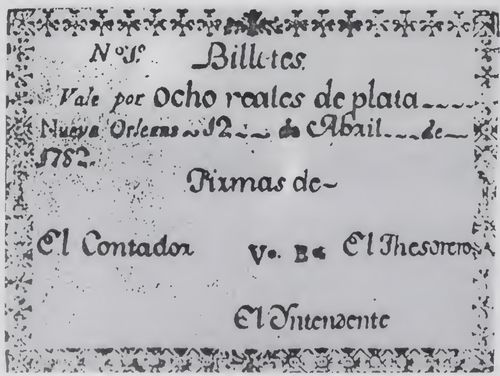Paper money of Luisiana
Louisiana (Luisiana) was a province of New Spain from 1762 to 1801. The area had originally been claimed and controlled by France: Spain secretly acquired the territory from France near the end of the Seven Years' War by the terms of the Treaty of Fontainebleau (1762). The actual transfer of authority was a slow process, and after Spain finally attempted to fully replace French authorities in New Orleans in 1767, French residents staged an uprising which the new Spanish colonial governor did not suppress until 1769. Spain also took possession of the trading post of St. Louis and all of Upper Louisiana in the late 1760s, though there was little Spanish presence in the wide expanses of what they called the "Illinois Country".
New Orleans was the main port of entry for Spanish supplies sent to American forces during the American Revolution, and Spain and the new United States disputed the borders of Louisiana and navigation rights on the Mississippi River for the duration of Spain's rule in the colony. New Orleans was devastated by large fires in 1788 and 1794 which destroyed most of the original wooden buildings in what is today the French Quarter. New construction was done in the Spanish style with stone walls and slate roofs, and new public buildings constructed during the city's Spanish period.
Louisiana was later and briefly retroceded back to France under the terms of the Third Treaty of San Ildefonso (1800) and the Treaty of Aranjuez (1801). In 1802, King Charles IV of Spain published a royal bill on 14 October, effecting the transfer and outlining the conditions. Spain agreed to continue administering the colony until French officials arrived and formalized the transfer. After several delays, the official transfer of ownership took place at the Cabildo in New Orleans on 30 November 1803. Three weeks later on 20 December, another ceremony was held at the same location in which France transferred New Orleans and the surrounding area to the United States pursuant to the Louisiana Purchase.
Paper money
100,740 pesos in peso denominations of Spanish notes and an unknown amount of denominations in reales were received in New Orleans in June 1782 by the fifth Spanish governor of Luisiana, Don Esteban Rodríguez Miro (1744-1795) and were intended to be used to pay soldiers.
The peso denominations are detailed on a manifest prepared in New Orleans and were to be signed by the Comptroller (Contador), Treasurer (Thesorero) and Intendant (Intendente) of the Colony when issued.
 M Unlisted Luisiana 2r
M Unlisted Luisiana 2r
 M Unlisted Luisiana 8r
M Unlisted Luisiana 8r
 M Unlisted Luisiana 8r de plata
M Unlisted Luisiana 8r de plata
| Date on note | from | to | Total number | Total value | |
|---|---|---|---|---|---|
| 2 Reales | |||||
| 4 Reales | |||||
| 8 Reales | |||||
| 8 Reales Fuertes | 12 April 1782 | 50,000 | 50,000 | ||
| 2 Pesos Fuertes | 20,000 | 40,000 | |||
| 2½ Pesos Fuertes | 20,000 | 50,000 | |||
| 5 Pesos Fuertes | 5,800 | 29,000 | |||
| 10 Pesos Fuertes | 3,000 | 30,000 | |||
| 20 Pesos Fuertes | 1,000 | 20,000 | |||
| 25 Pesos Fuertes | 400 | 10,000 | |||
| 30 Pesos Fuertes | 300 | 9.000 | |||
| 50 Pesos Fuertes | 240 | 12,000 |
The illustrations are from specimens in the Archivo General de Indias (General Archives of the West Indies) in Seville, Spain. The issue was printed in Spain and was the first paper money prepared for Spain or its dominions.
The lowest three denominations in reales were undated. Some specimens show rúbrica or flourishes in the place of official signatures.
One variety of 8 reales and all of the peso denominations specified payment in silver. Coin was requested and apparently paper money was not acceptable since Antonio St. Maxent, the Commandante of the garrison at Galveston, wrote that his portion of the shipment arrived wet and were good for nothing.
Counterfeits
Counterfeits were known of the 8 reales fuertes, 2, 2½, and 10 pesos.
Pursuant to a trial in Natchez and continued in New Orleans in November 1782 Guillermo Jones and Alejandro Greden were executed for counterfeiting this issue.
Withdrawal
On 16 January 1789 redemption of all Spanish paper money began pursuant to the Royal Order of October 1788 following the fire in New Orleans.
